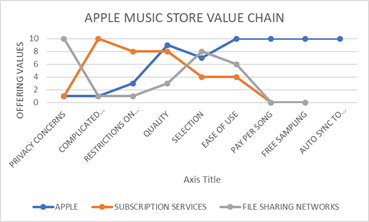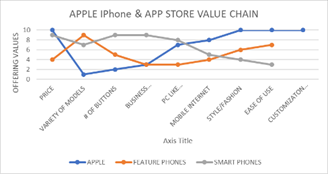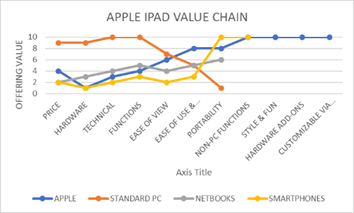Strategic Management of Apple’s Corporate Strategy
| ✅ Paper Type: Free Essay | ✅ Subject: Management |
| ✅ Wordcount: 1999 words | ✅ Published: 23 Sep 2019 |
- In video A what did Steve Jobs eliminate, reduce, rise create
In the video, Steve Jobs’ outline his vision for a new overall corporate strategy for Apple moving forward. He first eliminated 70% of Apple’s product road map. Noting that the mix was too large and confusing not only to himself but to customers. He noted that they would focus on the 30% winning products and that Apple would be introducing new innovative products. Key messaging related to the fact that Apple had fallen behind in innovation and strayed from their core. He also noted that they would be reducing inventory levels and would be improving overall distribution and manufacturing processes. His goal was to do a better job matching customer demand with inventory levels. His commitment was that Apple would be investing in new distribution and manufacturing innovations and that Apple would be one of the best in this area. Finally, the other key message in the video was the corporate commitment to make large investments in a new Brand marketing campaign. One that focused on Apple’s core values and would encourage people to “think differently”. This video highlights some key strategic pivot points that has driven Apple’s current success. “We will have GREAT products, marketing and distribution”.
- In video B you will see pictures of 17 individuals. What did apple want its campaign to reflect through these individuals?
The individuals reflected in the video are all individuals who have had an impact on society. These are all individuals who are adventurous, pioneers, social advocates, free spirits who have left their marks in the world. Apple is messaging that their products are made for those who “think differently”. Those who walk a different path than the majority. Apple is communicating that they are a company made for those who want something different, those who want something more and those who like to challenge the status quo. “The type of people that if given an opportunity would have used a MAC”. They are also making a reference that Apple, as an organization, like those reflected are not fond of rules, they challenge the status quo and they want to change the world. A reflection of their organization core values.
- What were Apple’s Blue Ocean strategic moves from 2001 to 2011; Focus on the iPod (2001); iTunes Music Store (2003); iPhone (2007); AppStore (2008); iPad (2010). Outline their strategic moves and draw the corresponding ‘Value map.”
The MP3 industry in the late 1990s was targeted to a consumer base age of teens to those 20 years of age. The industry had two options; low cost, small size, small storage (1CD), medium ease of use, navigation and music transfer and organization of flash MP3 players or the high cost, bulky size, large storage, low ease of use, navigation and music transfer and organization of Hard drive MP3 players. Apple’s strategy was to develop an MP3 device that combined the best of both and added new innovative technologies. The iPod was targeted to consumers of a higher age (over 34yrs) which could afford its higher price. It had the storage capacity of a hard drive MP3 players but the portability and ease of use of a flash drive MP3. It also had a simplified user interface and included a new iTunes software application that was simple to use, allowed for easy transfer of music from a CD, created a simple music library for organization, allowed for battery charging via a PC and it synchronized quickly with the iPod. Finally, it had a new sleek design and was fun to use.
At the time of iTunes Music Store launch, digital music was predominately obtained by consumers through either legal subscription-based service which offered good quality music but was limited in its selection and often had complex pricing strategies. Users also tended to trade up and or down with often illegal file sharing networks where music was free, easy to share, had wide selections but in which the quality of the files being shared often lacked in quality. Again, in the case of the iTunes music store we see Apple looking across both industry options. Apple saw an opportunity in user demand. Recognizing a need for legal options that offered the ease of file sharing and a wide selection that the free networks offered but also understood the need to keep prices low as to capture a price sensitive market. The understood the need to increase music quality and opening consumers ability to share purchased content. They created a price per song model and allowed users to dry run material before purchase through a 30 second free sample. The store also quickly synced to MP3 players.
Apple’s iPhone and App Store though two separate initiatives are born from one thought. The second would not have existed without the other. The mobile phone industry at the time was segmented into two devices; feature phones and smart phones. Makers were making large investment in R&D and driven by unit sales. While carriers were under pressure in a flooded market to keep prices low. Apple’s strategy was to eliminate a variety of models and to create a device that would bring the internet to your pocket. One that was simple to use, could be customized, was highly stylized and focused in its new design that had less buttons, embedded business applications and had improved operating system. The App Store was born from the one goal of making the iPhone customizable to the users. An experience that was unique in the iPhone. The App store allowed users to customize their phone experience through various applications in categories such as games, entertainment, and literature. Apps were created by both Apple and third-party developers. Apple would sell third party applications for 30% of the generated sales. Purchasing the apps aligned with Apple core of ease of use, by allowing users to purchase, download and sync with one single Apple ID.
Finally, we come to the iPad launched by Apple in 2010. The PC industry at this point was an era where the PC had become a commodity, PC sales were declining, and US companies faced the threat of global competition. The industry also saw the introduction of Netbooks, which were basically cheap low-end laptops and it faced its biggest threat of substitution the smartphone. Apple’s blue ocean strategy began with a simple question; whether they could create a third product, one that is neither PC or smartphone. Instead of offering another high-end laptop or lower end Netbook could they create something new that gave its users even greater flexibility. The answer was “yes”. Apple’s strategy was to eliminate traditional PC hardware features, increase ease of use and viewability, make it intuitive, make it portable and include new functions such as handheld gaming and e-reading capabilities. The chose to reduce technology specs and functions, yet creating new hardware add-ons, i.e. key boards, while making it stylish, fun, and customizable via the App store. Apple’s Value Chain drawings for each key initiative can be found in Attachment 1
- In which industry did Apple create a Blue Ocean? Was that industry attractive?
This is a bit difficult to answer simply because Apple created a Blue Ocean in a multitude of industries. Apple’s has utilized Blue Ocean thinking in each of the initiatives noted above that crosses over to multiple industries. With the introduction of the iPod they disrupted the music player industry, with the introduction of iTunes the music and content distribution industry and with the iPhone & iPad, combined with the App store, the handset industry. However, for the purpose of this question I will focus on the broader technology device industry. By the time that Apple introduced the iPod in 2001, the first technology device, the PC industry, was unattractive. Porter’s Five forces indicate that an industry is unattractive when threats of entrants, threats of substitutes, the Bargaining Power of Buyers or Suppliers and the intensity of Rivalry are high. The PC industry was facing intensive competition on both domestic and global fronts, the industry was facing a new threat of substitution via smartphones, Buyers now had the option of purchasing lower end Netbooks and overall the PC was becoming a commodity.
- For the question above, was Apple a new entrant or incumbent in the industry?
Apple was an incumbent in the technology device industry. At one time Apple dominated the PC industry but had suffered a severe loss of market share by the time that Steve Jobs returned as CEO. Apple’s strategies are partly based on the need to address forces in the external business environment: Competitive rivalry or competition, bargaining power of buyers or customers, bargaining power of suppliers, threat of substitutes or substitution, and threat of new entrants or new entry (moderate force). Competitive rivalry is one of the most critical factors in its strategic focus. Companies like Samsung, LG and others continue to aggressively challenge Apple in competing for market share. Low switching costs increase the bargaining power of consumers, making them a strong force for Apple. Bargaining power of suppliers for Apple on the other hand are a weak force for driving Apple’s strategies. Apple has many options for suppliers across the world and a large supply of components which accounts for weak supplier bargaining power. Threat of substitution is not a key driver of Apple’s strategies. There are numerous substitutes for consumers to use, i.e. a digital camera vs iPhone for taking pictures, Android options, etc. The reality is that the consumers of Apple products choose them over other substitutes largely due to the enhanced features and buyer loyalty. Regarding threats of new entries, establishing a business to compete against Apple requires a large commitment of upfront capital. Also, it is considerable costly to develop a strong brand capable of competing with them.
- Summarize the logic of the Blue Ocean Strategy in a digital world
The logic of Blue Ocean Strategy, value innovation, begins with asking 4 basic questions that form into an actionable framework (Murray, 2009);
- Which of the factors that our industry takes for granted should we eliminate?
- Which factors should we reduce well below the industry’s standards?
- Which factors should we raise well above the industry’s standard?
- Which factors should we create that the industry has never offered?
Blue Ocean strategy is the belief that instead of searching within the boundaries of industry competition, we should look beyond those boundaries to find new markets that represent real value innovation (Santa-Cruz, 2008). The strategy is a shift in perspective from the current competition to new alternatives and from current customers to non-customers. The steps to implementing the four action frameworks include reconstructing market boundaries, focusing on the bigger picture, reaching beyond the existing demand, getting the strategic sequence right, overcoming organizational hurdles and building execution into strategy. In a digital world, the possibilities are endless. In a digital world where data is ever present, platforms are created, and communities are formed using the Blue Ocean’s strategic framework. Organizations like Amazon and Apple have developed digital platforms and tapped into new markets, along with creating strong consumer communities around their brand all by utilizing Blue Ocean thinking. In order to compete against these giants, competitors must avoid competing head to head. Apple continuously looks to implement new Blue Ocean strategies, such as the strategies noted above and new areas, such as Apple Pay and Apple TV.
Attachment 1 (Excel Workbook Attached separately)




References
- Apple, Inc. Form 10K
- W. Chan, K., Mauborgne, Renee (2004). Value Innovation: The Strategic Logic of High Growth. Retrieved from https://hbr.org/2004/07/value-innovation-the-strategic-logic-of-high-growth
- Ferguson, Edward. (2017), “Apple, Inc. Five Forces Analysis”, Panmore Institute
- Mahajan, Sachin, (2017), “What Industries has Apple Impacted or Disrupted”, Quora, https://www.quora.com/What-industries-has-Apple-disrupted-or-impacted
- Murray, A. (2009). The Wall Street Journal Guide to Management. Retrieved from http://guides.wsj.com/management/strategy/what-is-blue-ocean-strategy/
- Santos-Cruz, Rui. (2016), “The Blue Ocean Strategy: The Apple Case” Techno Institute, Lisbon Portugal, https://fenix.tecnico.ulisboa.pt/downloadFile/563568428717412/ESer.15.16-Lecture-10.pdf
Cite This Work
To export a reference to this article please select a referencing stye below:
Related Services
View allDMCA / Removal Request
If you are the original writer of this essay and no longer wish to have your work published on UKEssays.com then please click the following link to email our support team:
Request essay removal


